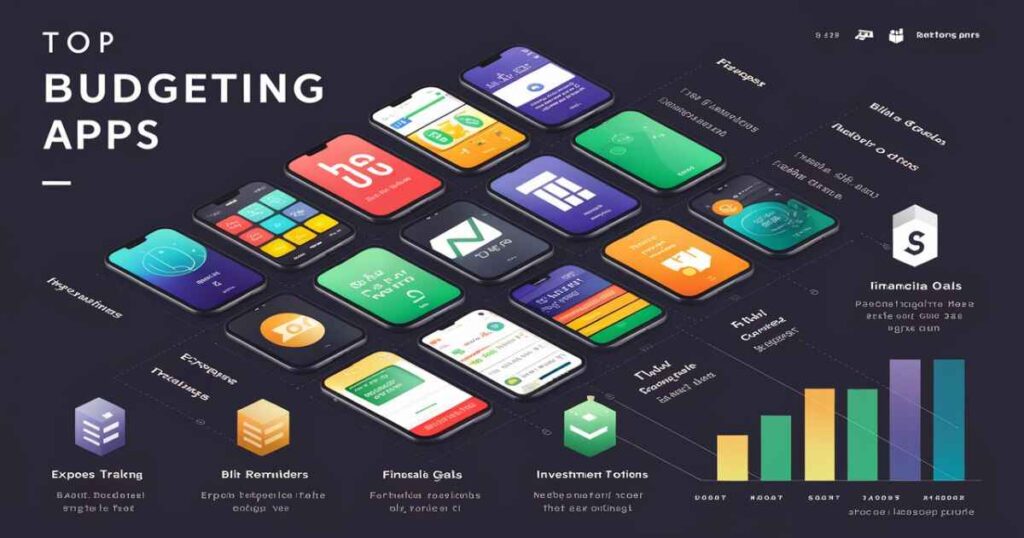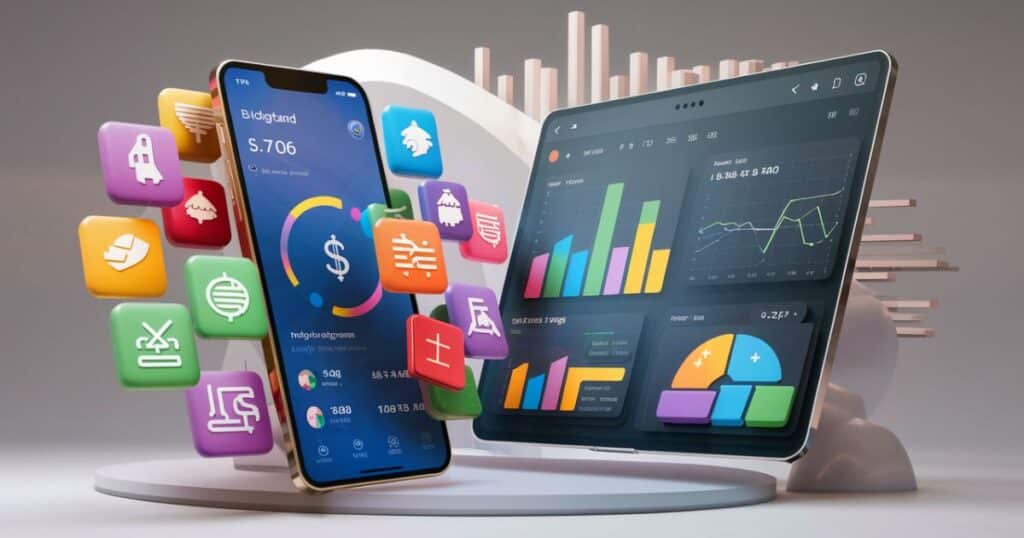In today’s fast-paced digital world, managing your finances has become increasingly complex. While the traditional pen-and-paper method was once the go-to approach for budgeting, the rise of online budgeting apps has revolutionized the way we track our expenses and plan for our financial goals.
These apps offer a host of features and advantages that make them a more effective solution for modern money management.
Introduction to Online Budgeting Apps
Online budgeting apps, also known as personal finance apps or money management apps, are software programs designed to help individuals and households track their income, expenses, and overall financial health. These apps sync with your bank accounts, credit cards, and other financial accounts, automatically categorizing transactions and providing real-time updates on your spending and savings.
As our lives become increasingly digital, the convenience and accessibility of online budgeting apps have made them a popular choice for those seeking to gain control over their finances. With a few taps on your smartphone or a few clicks on your computer, you can access a comprehensive view of your financial situation, anytime, anywhere.
Thesis: While pen-and-paper budgeting has its merits, online budgeting apps offer significant advantages that make them a more effective solution for managing your money in today’s world.
Real-time Tracking for Informed Decision Making

Track Where Your Money is Going
One of the primary benefits of online budgeting apps is their ability to provide real-time tracking of your spending habits. By automatically categorizing your transactions, these apps give you a clear picture of where your money is going. Whether it’s dining out, groceries, transportation, or entertainment, you can quickly identify areas where you may be overspending or where you can potentially cut back.
This level of transparency is crucial for making informed decisions about your finances. Instead of relying on manual calculations or estimates, you have access to accurate, up-to-date data that reflects your true spending patterns.
Fill In and Add Up Expenses
Gone are the days of manually entering every purchase and painstakingly adding up your expenses. Online budgeting apps do the math for you, automatically tallying your spending and comparing it to your budgeted amounts. Many apps even provide visual representations, such as graphs or charts, that highlight when you’re over or under budget in different categories.
This automation not only saves time but also reduces the potential for human error, ensuring that your budgeting information is accurate and reliable.
Automation Streamlines Financial Management
Beyond tracking and categorization, online budgeting apps offer a range of automation features that can streamline your financial management process. Many apps allow you to set up automatic bill payments, ensuring that you never miss a due date and incur late fees or penalties.
Additionally, some apps can automatically transfer funds from your checking account to your savings or investment accounts on a set schedule. This feature can be particularly useful for building an emergency fund or working towards specific financial goals, such as saving for a down payment on a house or planning for retirement.
By automating these tasks, online budgeting apps reduce the mental load and effort required to stay on top of your finances, freeing up your time and energy for other important aspects of your life.
Access Anytime, Anywhere
In our increasingly mobile society, the ability to access your financial information on the go is invaluable. Online budgeting apps are cloud-based, meaning that your data is synchronized across all of your devices. Whether you’re at home, at work, or on the go, you can check your account balances, transactions, and budgeting progress with just a few taps or clicks.
This accessibility not only provides convenience but also enables you to make informed decisions in real-time. For example, if you’re out shopping and considering a purchase, you can quickly check your budget to see if it fits within your spending limits, helping you avoid impulse buys and stay on track with your financial goals.
Tips to Actually Use Your Budget:
- Set a routine: Establish a regular time, such as every Sunday evening, to review your budget and make any necessary adjustments.
- Use notifications and reminders: Many budgeting apps offer the ability to set up alerts and reminders, such as when a bill is due or when you’re approaching your budget limit in a particular category. These notifications can help you stay on top of your finances and avoid missed payments or overspending.
- Adjust limits as needed: As your income or financial goals change, be sure to adjust your budgeted amounts accordingly. Online budgeting apps make it easy to update your limits and categories, ensuring that your budget remains relevant and realistic.
The O.G. Budget: Pen and Paper
Before the advent of digital tools, pen-and-paper budgeting was the standard method for managing one’s finances. This approach involves manually writing down all income sources and expenses, categorizing them, and calculating totals to determine if you’re living within your means.
Pros of Using a Pen and Paper Budget
- Free: Pen-and-paper budgeting requires no subscription fees or additional costs, making it an accessible option for those on a tight budget.
- Simple and easily understood: The basic concept of tracking income and expenses is straightforward, requiring no specialized knowledge or training.
- Hands-on approach: Physically writing down your transactions can foster a deeper connection and awareness of your spending habits.
Cons of the Pen and Paper Budget
- Tedious data entry and calculations: Manually entering and adding up every transaction can be time-consuming and prone to errors, especially for those with a high volume of transactions.
- Static and inflexible: Once written down, your budget is fixed, making it difficult to adjust on the fly or account for unexpected expenses or income changes.
- Limited functionality: Pen-and-paper budgeting lacks the advanced features and tools offered by online budgeting apps, such as automatic categorization, bill reminders, and goal tracking.
- Easy to miss expenses: It’s easy to forget or overlook expenses, leading to inaccurate budgeting and potential overspending.
Budgeting Apps and Software
In contrast to the traditional pen-and-paper method, online budgeting apps and software offer a range of features and tools designed to simplify and streamline the budgeting process.
Pros of Using a Budgeting App
- Real-time tracking and sync: As mentioned earlier, budgeting apps automatically sync with your financial accounts, providing real-time tracking of your income and expenses across all your accounts.
- Automation and reminders: Apps can automate bill payments, transfers to savings accounts, and send reminders for due dates or when you’re approaching budget limits.
- Comprehensive financial tools: In addition to budgeting, many apps offer features for tracking investments, monitoring credit scores, planning for debt repayment, and setting financial goals.
- Shared access and coordination: Apps often allow you to share your budget with a partner or family members, enabling better coordination and collaboration on financial matters.
Cons of Using a Budgeting App
- Subscription costs: While some budgeting apps offer free versions, many of the more feature-rich options require a paid subscription, which can be a barrier for those on a tight budget.
- Learning curve: Setting up and understanding the full range of features in a budgeting app can involve a learning curve, especially for those who are less tech-savvy.
- Privacy and security concerns: To sync with your financial accounts, you must provide third-party access to your sensitive banking and credit card information, which may raise privacy and security concerns for some users.
Recommended Post: FintechZoom Msft Stock: Mastering MSFT Stock Investing
The Features of the Top Budgeting Apps

When it comes to choosing an online budgeting app, there are numerous options available, each with its own unique features and pricing structures. Here’s a comparison of some of the top budgeting apps on the market:
| App | Key Features | Pricing |
|---|---|---|
| Mint | – Automatic transaction categorization<br>- Investment tracking<br>- Free credit score monitoring<br>- Bill payment reminders | Free for basic features, premium subscriptions available |
| You Need a Budget (YNAB) | – Zero-based budgeting method<br>- Goal tracking<br>- Debt payoff tools<br>- Mobile apps and web access | $14.99/month or $98.99/year |
| PocketGuard | – Automatic categorization<br>- Cash flow calendar<br>- Negotiation tools for lowering bills<br>- Sync with over 15,000 financial institutions | $4.99/month or $34.99/year (after 1-month free trial) |
| Personal Capital | – Investment tracking and analysis<br>- Retirement planning tools<br>- Cash flow tracking<br>- Free financial advisory tools | Free for basic features, premium services available |
Many of these apps offer free trials or limited free versions, allowing you to test them out and determine which one best suits your budgeting needs and preferences.
Case Study: How Online Budgeting Helped a Family Achieve Financial Freedom
To illustrate the power of online budgeting apps, let’s explore a real-life case study. Meet the Johnsons, a family of four living in Chicago.
For years, the Johnsons struggled with overspending and mounting credit card debt. Despite their best efforts to budget using pen and paper, they often lost track of expenses or underestimated their spending in certain categories. This led to a vicious cycle of living paycheck to paycheck and relying on credit cards to make ends meet.
That’s when they decided to give online budgeting a try. After researching their options, they settled on YNAB (You Need a Budget) for its zero-based budgeting approach and debt payoff tools.
The Johnsons’ Experience with YNAB:
- Clarity and Awareness: By syncing their accounts and automatically categorizing transactions, the Johnsons gained a clear picture of where their money was going each month. They were shocked to discover how much they were spending on dining out and entertainment.
- Budgeting Every Dollar: YNAB’s zero-based budgeting method forced the Johnsons to give every dollar a job, whether it was for essentials like rent and groceries or discretionary spending. This helped them prioritize their spending and avoid mindless splurges.
- Debt Payoff Plan: Using YNAB’s debt payoff tools, the Johnsons created a plan to tackle their credit card debt systematically. They were able to visualize their progress and stay motivated throughout the journey.
- Savings Goals: With better control over their spending, the Johnsons were able to start building an emergency fund and save for other financial goals, like a family vacation and their children’s college funds.
“Online budgeting with YNAB completely transformed our relationship with money,” said Mrs. Johnson. “It gave us the tools and awareness we needed to break the paycheck-to-paycheck cycle and take control of our finances.”
Within two years of consistently using YNAB, the Johnsons had paid off all their credit card debt, saved a six-month emergency fund, and were on track to meet their other financial goals.
This case study highlights the tangible benefits of online budgeting apps and how they can empower individuals and families to achieve financial freedom and peace of mind.
Final Thoughts: The Advantages of Online Budgeting Apps
While pen-and-paper budgeting served its purpose for generations, the advent of online budgeting apps has ushered in a new era of financial management. These apps offer a level of real-time tracking, automation, and accessibility that simply cannot be matched by traditional methods.
By syncing with your accounts, categorizing transactions, and providing visual representations of your spending habits, online budgeting apps give you a clear and accurate picture of your financial situation. This level of transparency empowers you to make informed decisions and course-correct as needed, ensuring that you stay on track with your budgeting goals.
Additionally, the automation features offered by these apps, such as automatic bill payments and transfers to savings accounts, streamline the budgeting process and reduce the risk of missed payments or forgotten expenses.
Perhaps most importantly, online budgeting apps are designed for our modern, mobile lifestyles. With cloud-based access and synchronization across devices, you can monitor and manage your finances anytime, anywhere, ensuring that you’re always in control of your financial well-being.
While pen-and-paper budgeting will always have its place for those who prefer a more tactile approach, the advantages of online budgeting apps are undeniable. By embracing these digital tools, you can take a significant step towards achieving financial freedom, security, and peace of mind.

Howdy, editor at FinanceEon.com, brings over a decade of financial journalism experience. He ensures accuracy and insightful analysis, guiding a team on market trends and investment strategies.







